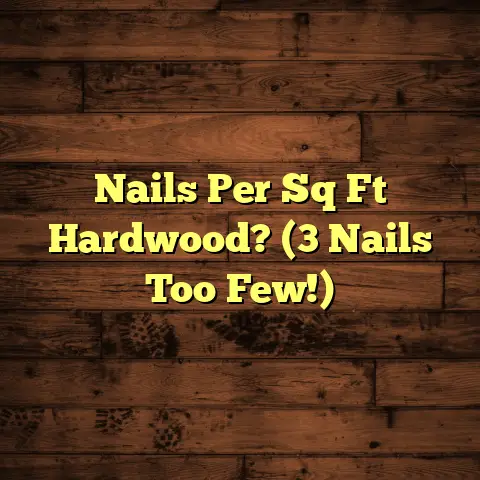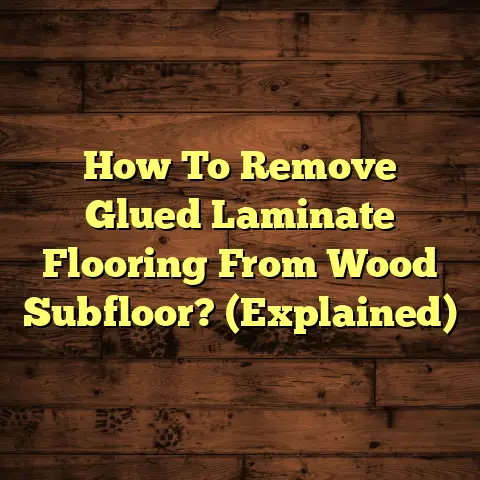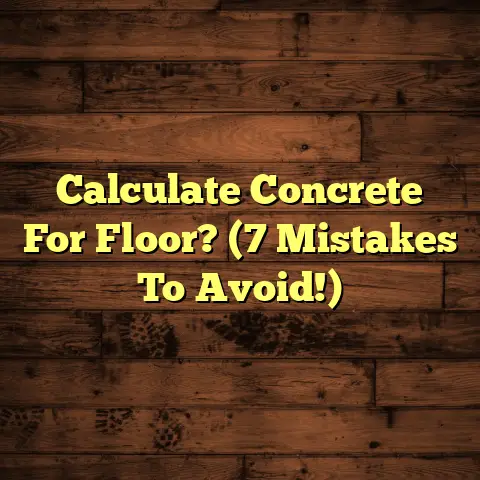How To Touch Up Wood Floors? (1-Day Fix!)
Let’s be honest, wood floors are the bomb. I’ve seen them transform houses into homes, adding that touch of elegance and warmth that everyone craves. You know, the kind of home that makes you want to kick off your shoes and sink into the couch with a cup of coffee? ☕
Wood floors have become a total status symbol. They’re the go-to choice for anyone who wants to create a space that’s both stylish and inviting. But here’s the thing: life happens. Kids, pets, parties… they all take a toll. 😩
Before you know it, your beautiful floors are sporting scratches, scuffs, and maybe even a few dents. And trust me, I’ve seen it all!
Now, you might be thinking, “Oh no, does this mean I need to completely refinish my floors?” Hold up! That’s where touch-ups come in. Think of it as a mini-makeover for your floors. It’s a way to breathe new life into them without breaking the bank or spending weeks covered in sawdust. Plus, it is a great way to keep your home in pristine condition.
I’m going to walk you through everything you need to know to touch up your wood floors like a pro. And the best part? You can get it done in just one day! So, grab your tools, and let’s get started!
Section 1: Understanding Wood Floors
Okay, before we dive into the nitty-gritty of touch-ups, let’s talk wood floors. It’s important to know what you’re working with so you can choose the right products and techniques.
Types of Wood Floors:
There are three main types of wood floors, each with its own personality and quirks:
- Solid Hardwood: This is the real deal. Think classic, timeless, and built to last. Solid hardwood is made from a single piece of wood, usually ¾ inch thick. It can be sanded and refinished multiple times, making it a great long-term investment. Oak, maple, and cherry are popular choices.
- Engineered Hardwood: Engineered hardwood is like the cooler, more versatile cousin of solid hardwood. It has a thin layer of real wood (the veneer) on top of multiple layers of plywood or fiberboard. This construction makes it more stable and less susceptible to moisture and temperature changes. It’s a great option for basements or areas with high humidity.
- Laminate: Laminate flooring is the budget-friendly option. It’s made of a composite material with a photographic applique layer that mimics the look of wood. While it’s not real wood, laminate is durable, easy to clean, and comes in a wide variety of styles.
To give you a better idea, here’s a quick comparison:
| Feature | Solid Hardwood | Engineered Hardwood | Laminate |
|---|---|---|---|
| Material | Solid Wood | Wood Veneer + Core | Composite |
| Cost | $$$ | $$ | $ |
| Refinishing | Multiple Times | Limited/Sometimes | No |
| Moisture Resist. | Low | Medium | High |
| Installation | Nail/Glue | Float/Glue/Nail | Click-Lock/Glue |
Common Issues with Wood Floors:
Now, let’s talk about the things that can go wrong. I’ve seen it all, from minor scratches to major water damage. Here are some of the most common culprits:
- Scratches: These are the most common offenders. They can be caused by anything from pet claws to furniture being dragged across the floor.
- Dents: Dents are usually caused by heavy objects being dropped on the floor. They can range from small, barely noticeable dings to larger, more obvious indentations.
- Fading: Sunlight can wreak havoc on wood floors, causing them to fade over time. This is especially noticeable in areas that get a lot of direct sunlight.
- Water Damage: Water is the enemy of wood floors. Spills, leaks, and high humidity can cause warping, cupping, and even rot.
These issues not only affect the appearance of your floors, but they can also impact their value and longevity. That’s why it’s so important to address them as soon as possible.
Benefits of Touching Up Wood Floors:
Okay, so why bother with touch-ups? Here’s the deal:
- Cost-Effective: Refinishing an entire floor can be expensive. Touch-ups are a fraction of the cost.
- Time-Saving: Refinishing can take days or even weeks. Touch-ups can be done in a single day.
- Convenient: You don’t have to move all of your furniture out of the room.
- Preserves Character: Sometimes, imperfections add character to a floor. Touch-ups allow you to address the problem areas while preserving the overall look and feel of your floors.
- Maintains Value: Keeping your floors in good condition helps maintain the value of your home.
According to a recent survey by the National Association of Realtors, homes with hardwood floors sell for an average of 2.5% more than homes without them. That’s a pretty good incentive to keep your floors looking their best!
Section 2: Tools and Materials Needed
Alright, let’s get down to business. Before you start touching up your floors, you’ll need to gather the right tools and materials. Trust me, having everything on hand will make the process go much smoother.
Essential Tools:
- Sandpaper (Various Grits): You’ll need a range of grits, from coarse (80-grit) for removing scratches and dents to fine (220-grit) for smoothing the surface.
- Sanding Block or Orbital Sander: A sanding block is great for small areas, while an orbital sander will make quick work of larger areas.
- Wood Filler: Choose a wood filler that matches the color of your floors.
- Putty Knife: For applying and smoothing wood filler.
- Clean Cloths: For wiping away dust and applying stain and sealant.
- Stain Applicators: Foam brushes, rags, or cotton swabs work well for applying stain.
- Sealant Applicator: A brush or foam pad for applying sealant.
- Vacuum Cleaner: For cleaning up dust and debris.
- Tack Cloth: For removing fine dust particles before staining and sealing.
- Safety Glasses: To protect your eyes from dust and debris.
- Gloves: To protect your hands from stain and sealant.
Materials:
- Wood Filler: As I mentioned, choose a wood filler that matches the color of your floors. You can also find stainable wood fillers if you want to customize the color.
- Stain: This is where things can get tricky. You’ll need to find a stain that matches the existing color of your floors as closely as possible. I recommend taking a sample of your flooring to the hardware store and comparing it to the stain swatches.
- Sealant: A sealant will protect your floors from scratches, stains, and water damage. Choose a sealant that’s designed for wood floors. Polyurethane is a popular choice.
- Mineral Spirits: For cleaning your brushes and removing excess stain.
Pro Tip: When choosing a stain, always test it on a hidden area of your floor first. This will give you a better idea of how the color will look and ensure that it matches your existing flooring.
Here’s a handy checklist to make sure you have everything you need:
| Tool/Material | Quantity | Notes |
|---|---|---|
| Sandpaper | Assorted | 80-grit, 120-grit, 220-grit |
| Sanding Block/Sander | 1 | Choose based on the size of the area you’re touching up |
| Wood Filler | 1 | Color-matched to your floors |
| Putty Knife | 1 | Flexible blade |
| Clean Cloths | Several | Lint-free |
| Stain Applicators | Several | Foam brushes, rags, cotton swabs |
| Sealant Applicator | 1 | Brush or foam pad |
| Vacuum Cleaner | 1 | With a brush attachment |
| Tack Cloth | 1 | |
| Safety Glasses | 1 | |
| Gloves | 1 pair | |
| Stain | 1 | Color-matched to your floors |
| Sealant | 1 | Polyurethane is a good option |
| Mineral Spirits | 1 | For cleaning |
Section 3: Preparing the Area
Okay, now that you’ve got your tools and materials, it’s time to prep the area. This is a crucial step, so don’t skip it! A little preparation can make a big difference in the final result.
Clearing the Space:
The first thing you need to do is clear the area you’ll be working on. This means moving furniture, rugs, and anything else that might get in the way. Trust me, you don’t want to be tripping over a coffee table while you’re trying to sand a scratch.
If you can’t move everything out of the room, cover it with drop cloths or plastic sheeting to protect it from dust and spills.
Cleaning the Floors:
Next, you need to give your floors a good cleaning. This will remove any dirt, dust, or grime that could interfere with the touch-up process.
Here’s my step-by-step cleaning process:
- Vacuum: Start by vacuuming the entire area to remove loose dirt and debris. Use a brush attachment to get into the corners and along the baseboards.
- Damp Mop: Next, damp mop the floors with a wood floor cleaner. Be sure to use a cleaner that’s specifically designed for wood floors. Avoid using harsh chemicals or abrasive cleaners, as these can damage the finish.
- Dry: After mopping, dry the floors with a clean cloth. Don’t let water sit on the surface for too long, as this can cause water damage.
Pro Tip: I always recommend using a microfiber mop for cleaning wood floors. They’re super absorbent and won’t scratch the finish.
Assessing Damage:
Now that your floors are clean, it’s time to take a good look at the damage. This will help you determine the best approach for touching up the area.
- Scratches: Are they deep or superficial? Can you feel them when you run your finger over them?
- Dents: How big are they? Are they sharp and defined, or more rounded?
- Fading: Is the color uneven across the floor?
- Water Damage: Are there any signs of warping, cupping, or discoloration?
Once you’ve assessed the damage, you can start planning your attack. For minor scratches, you might be able to get away with just sanding and sealing. For deeper scratches or dents, you’ll need to use wood filler. And for fading, you might need to stain the entire area.
To give you a better idea, here’s a quick guide:
| Damage Type | Severity | Recommended Approach |
|---|---|---|
| Scratches | Minor | Sand lightly with fine-grit sandpaper and apply sealant. |
| Deep | Sand with medium-grit sandpaper, apply wood filler, sand smooth, stain (if necessary), and apply sealant. | |
| Dents | Small | Apply a damp cloth and iron over the dent to raise the wood fibers. If that doesn’t work, use wood filler, sand smooth, stain (if necessary), and apply sealant. |
| Large | Use wood filler, sand smooth, stain (if necessary), and apply sealant. | |
| Fading | Mild | Apply a wood restorer or rejuvenator. |
| Severe | Sand the entire area, stain to match the surrounding flooring, and apply sealant. | |
| Water Damage | Minor | Dry the area thoroughly and apply a wood restorer or rejuvenator. |
| Severe | Replace the damaged boards. |
Section 4: The Touch-Up Process
Alright, it’s time to get our hands dirty. Here’s where the magic happens! I’m going to walk you through each step of the touch-up process, from sanding to sealing.
Step 1: Sanding the Affected Area:
Sanding is the key to a smooth, seamless repair. It’s important to be gentle and patient, and to use the right sandpaper grit for the job.
- Choose Your Grit: For minor scratches, start with 220-grit sandpaper. For deeper scratches or dents, start with 120-grit or even 80-grit.
- Sand Lightly: Using a sanding block or orbital sander, sand the affected area in the direction of the wood grain. Apply light pressure and avoid sanding too much in one spot.
- Feather the Edges: As you sand, feather the edges of the sanded area to blend it in with the surrounding flooring. This will help prevent a noticeable line between the repaired area and the rest of the floor.
- Check Your Progress: After sanding for a few minutes, stop and check your progress. Run your finger over the sanded area to see if it’s smooth and even. If not, continue sanding until you achieve the desired result.
- Vacuum and Tack Cloth: Once you’re satisfied with the sanding, vacuum up the dust and wipe the area with a tack cloth to remove any remaining particles.
Pro Tip: If you’re using an orbital sander, be sure to keep it moving at all times. Don’t let it sit in one spot, as this can create swirl marks.
Step 2: Applying Wood Filler:
Wood filler is your best friend when it comes to repairing deeper scratches or dents. It fills in the gaps and creates a smooth, even surface for staining and sealing.
- Choose the Right Filler: As I mentioned before, choose a wood filler that matches the color of your floors. You can also find stainable wood fillers if you want to customize the color.
- Apply the Filler: Using a putty knife, apply the wood filler to the damaged area. Overfill the area slightly, as the filler will shrink as it dries.
- Smooth the Filler: Use the putty knife to smooth the filler and remove any excess. Try to create a seamless blend with the surrounding wood.
- Let it Dry: Allow the filler to dry completely according to the manufacturer’s instructions. This can take anywhere from a few hours to overnight.
- Sand Smooth: Once the filler is dry, sand it smooth with fine-grit sandpaper (220-grit). Be careful not to sand too much, as this can remove the filler and expose the damaged area.
- Vacuum and Tack Cloth: Vacuum up the dust and wipe the area with a tack cloth.
Pro Tip: To prevent the wood filler from sticking to your putty knife, you can lightly coat the blade with mineral spirits.
Step 3: Staining the Repaired Area:
If you had to use wood filler, chances are you’ll need to stain the repaired area to match the surrounding flooring. This can be a bit tricky, but with a little patience and practice, you can achieve a seamless blend.
- Choose the Right Stain: As I mentioned before, it’s crucial to choose a stain that matches the existing color of your floors as closely as possible. Take a sample of your flooring to the hardware store and compare it to the stain swatches.
- Test the Stain: Before applying the stain to the repaired area, test it on a hidden area of your floor to make sure it’s a good match.
- Apply the Stain: Using a foam brush, rag, or cotton swab, apply the stain to the repaired area. Apply it in thin, even coats, following the direction of the wood grain.
- Wipe Off Excess Stain: After a few minutes, wipe off any excess stain with a clean cloth. This will help prevent the stain from becoming too dark.
- Let it Dry: Allow the stain to dry completely according to the manufacturer’s instructions. This can take anywhere from a few hours to overnight.
- Apply Additional Coats: If the stain is too light, you can apply additional coats until you achieve the desired color.
Pro Tip: To create a more natural look, you can blend the stain into the surrounding flooring by feathering the edges with a clean cloth.
Step 4: Sealing the Repair:
Sealing is the final step in the touch-up process. It protects the repaired area from scratches, stains, and water damage, and it gives the floor a uniform finish.
- Choose the Right Sealant: Choose a sealant that’s designed for wood floors. Polyurethane is a popular choice because it’s durable and water-resistant.
- Apply the Sealant: Using a brush or foam pad, apply the sealant to the repaired area. Apply it in thin, even coats, following the direction of the wood grain.
- Let it Dry: Allow the sealant to dry completely according to the manufacturer’s instructions. This can take anywhere from a few hours to overnight.
- Apply Additional Coats: For added protection, you can apply additional coats of sealant. Be sure to sand lightly between coats with fine-grit sandpaper (220-grit).
Pro Tip: To prevent bubbles from forming in the sealant, avoid shaking the can before applying it.
Step 5: Final Touches and Clean-Up:
Congratulations, you’ve successfully touched up your wood floors! Now it’s time for the final touches and clean-up.
- Inspect Your Work: Take a good look at the repaired area to make sure it’s smooth, even, and blends in with the surrounding flooring. If you see any imperfections, you can touch them up with a little more stain or sealant.
- Clean Up: Clean up your tools and materials. Dispose of any rags or brushes that have been used with stain or sealant properly.
- Reintroduce Furniture: Once the sealant is completely dry, you can reintroduce your furniture to the area. Be careful not to drag the furniture across the floor, as this can scratch the finish.
- Maintain Your Floors: To keep your floors looking their best, sweep or vacuum them regularly. You can also damp mop them with a wood floor cleaner as needed.
Pro Tip: Place felt pads under the legs of your furniture to prevent scratches.
Conclusion
There you have it! You’ve successfully touched up your wood floors in just one day. I know it might seem like a lot of work, but trust me, it’s worth it. Not only will you save money by avoiding a full refinishing, but you’ll also get the satisfaction of knowing that you did it yourself.
And let’s be real, there’s nothing quite like the feeling of stepping back and admiring your handiwork. You’ve taken your floors from drab to fab, and you’ve added value to your home in the process.
So, go ahead and pat yourself on the back. You’re a DIY flooring master! And remember, with a little bit of effort and the right tools, you can keep your wood floors looking stunning for years to come. Now go enjoy your beautiful floors! ✨





